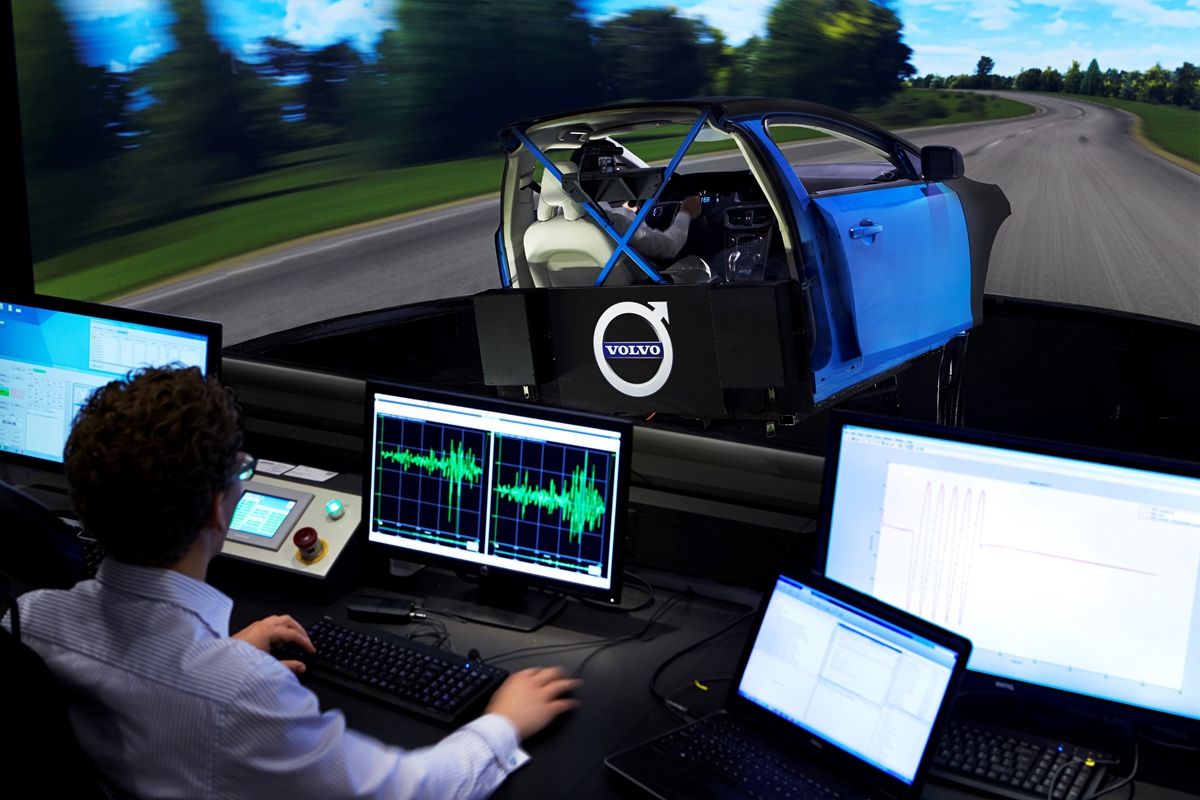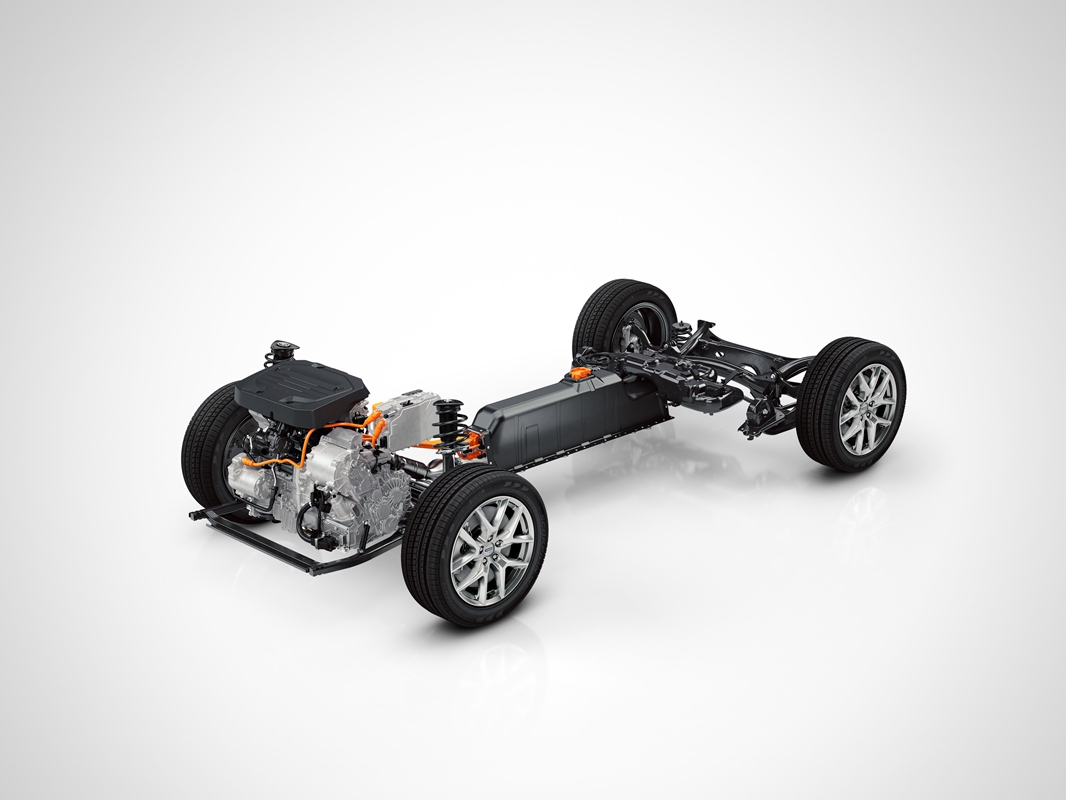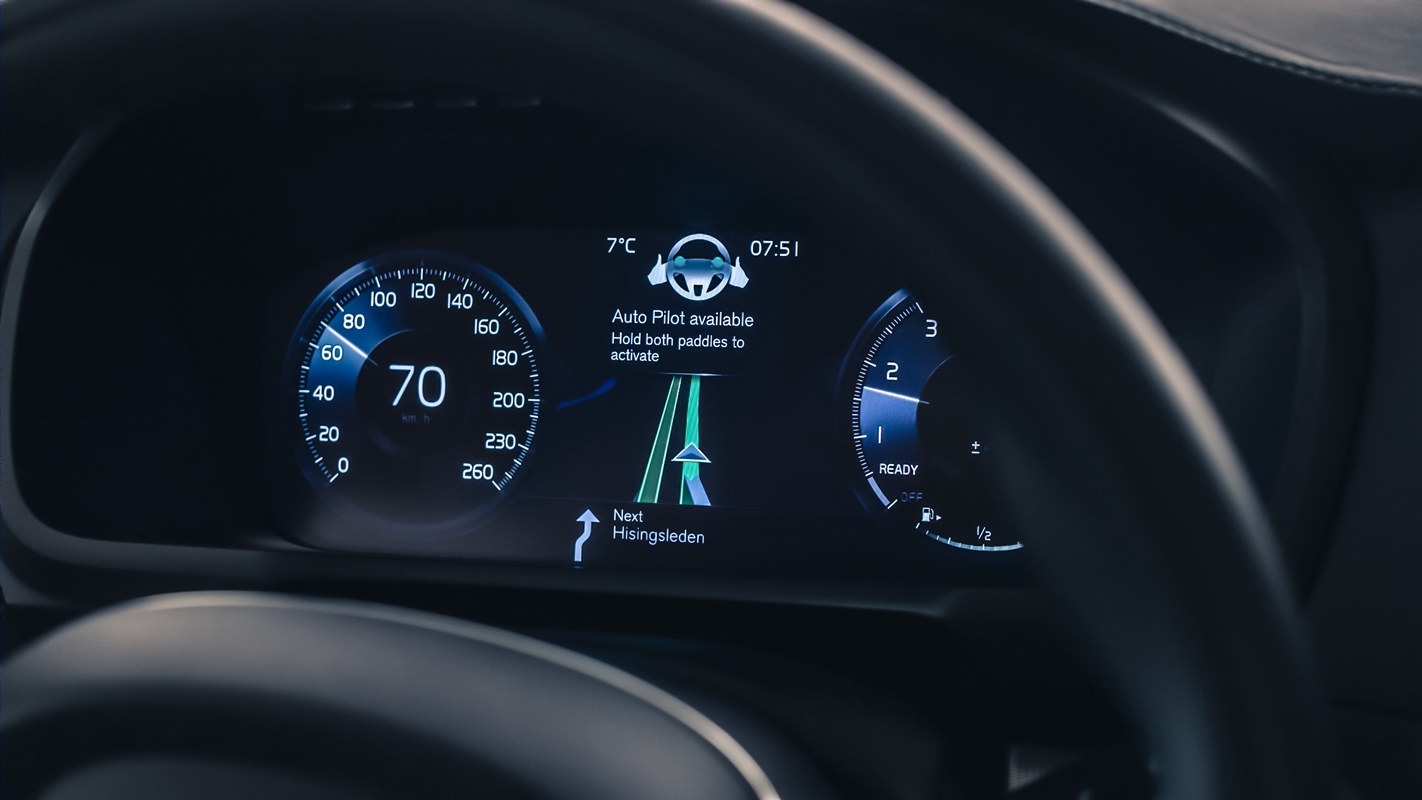 CEO Håkan Samuelsson表示2020年前推出的沃尔沃车型中将有10%实现电气化。
CEO Håkan Samuelsson表示2020年前推出的沃尔沃车型中将有10%实现电气化。 沃尔沃研发主管Peter Mertens表示,电气化的成本收益率“现在是正数”。
沃尔沃研发主管Peter Mertens表示,电气化的成本收益率“现在是正数”。 沃尔沃正在努力通过一个高度精致的VI-grade模拟器实现其技术目标;图为Driver-in-Motion系统和控制室。
沃尔沃正在努力通过一个高度精致的VI-grade模拟器实现其技术目标;图为Driver-in-Motion系统和控制室。 沃尔沃CMA底盘上的双引擎配置。
沃尔沃CMA底盘上的双引擎配置。 一辆载有自动驾驶系统的沃尔沃车型的仪表板上显示出全新的图样设计。
一辆载有自动驾驶系统的沃尔沃车型的仪表板上显示出全新的图样设计。
若问汽车消费者沃尔沃最大的卖点是什么,虽然听起来有些奇怪,但最常见的回答竟是安全性。但沃尔沃正在迅速地调整姿态,希望呈现一幅更宽广、更全面的先进技术应用图景,其中包括自动驾驶和无人驾驶、底盘优化和电气化等技术。这样做只有一个目的:扩大品牌的认知特点,提升品牌形象。
沃尔沃的电气化项目非常广泛。沃尔沃总裁兼CEO Håkan Samuelsson表示:“我们有信心在2020年前使电气化汽车的销量达到全球销量的10%。”他指出,这也将是电动汽车技术从小众领域上升为全球主流市场的时机。
沃尔沃选择的路线是插电式混合动力汽车(PHEV),因为这种方案能够很好地兼顾效率、里程和便捷程度。沃尔沃所有的车型系列都将采用这一技术。此外,沃尔沃正在研发一种“全新的电气化小型汽车系列”和一款全电动汽车,有望于2019年上市。据称,这款电动汽车的单次充电里程将达到500 km (311英里),这意味着它的日常实用程度很高,车主无需受到里程焦虑的困扰。
沃尔沃高级研发副总裁Peter Mertens博士进一步提到了投资方面的动机:“现在,电气化的成本收益计算结果已经转负为正了。”
新一代XC90的PHEV版本便是这一研发项目的一部分,目前已经更名为T8 Twin Engine(汽油机和电机),进入了一些国家的市场。新S90轿车也将推出PHEV版本,而60系列也将使用沃尔沃专为大型汽车研发的可扩展产品架构(SPA)。
对于体型较小的40系列,沃尔沃计划推出全新的前轮驱动版和PHEV版,支撑该目标的技术是沃尔沃最新的紧凑型模块架构(CMA)。这些车型将于2017年上市。此外,沃尔沃和吉利之间的平台共享,也促进了研发新底盘的成本收益率的上升。
全新的主动安全控制策略
为了支持全新的底盘研发,沃尔沃安装了一个名为DiM(运动中的驾驶员)的运动平台,这个模拟器由VI-grade(一家全球性的工程模拟专业公司)设计,并由日本鹭宫制作所生产。这个全新的驾驶模拟器动态平台已成为沃尔沃瑞典Torslanda工厂的交钥匙解决方案,将用于新车型的测试、操纵和驾驶行为优化、以及新的主动安全控制算法的测试。
有9个自由度级别的DiM平台是专门为了发挥MotionCueing的优势,并配合VI-grade及其合作伙伴开发的其他软件而设计的。
DiM概念可以延长运动包络,并区分高低频致动因素,因此这类运动平台“独一无二,而且汽车动态研究与驾驶研究均适用,” VI-grade表示。
这个模拟器可以对高速稳定性、平衡性和个人驾驶模式的早期研发提供支持,不仅为设计概念阶段的创新活动提供更大空间,而且还能缩短研发时间,这对沃尔沃的发展战略非常重要。Mertens表示:“我们的目标是实现车轮的全面控制、高度的便捷和灵活性。我们将在沃尔沃的整个汽车系列中改善驾驶性能。”
在该项目进行的同时,沃尔沃也没有放松不断提高车辆安全性能的长期计划,其中包括实现事故死亡率和严重事故率为零的目标。沃尔沃借用第三方统计数据称,超过90%的致命事故都是由人为因素造成的,而且主要原因是驾驶员注意力分散。
沃尔沃期待自动驾驶(AD)技术可成为实现这一目标的有力支撑。为了强调这一理念的重要性,沃尔沃表示将努力实现驾驶员与车辆之间“安全且无缝的切换”。而人机界面(HMI)是所有新AD技术可靠性的基石,沃尔沃强调。
逐步实现IntelliSafe的生产
为了实现这一目标,沃尔沃研发了一个名为IntelliSafe Auto Pilot(自动驾驶)的系统。它的设计标准要求操作必须简单直观,因此自动模式的开启和关闭是通过方向盘上的拨片完成的。这个拨片虽然很像换档拨片,但无论在触觉还是视觉上都有很大区别。搭载IntelliSafe Auto Pilot系统的沃尔沃车型可以自动识别出AD的指定路段,向驾驶员发送一条确认信息并开启拨片上的闪灯。
接着驾驶员通过同时拉动拨片启动AD,这时绿色的确认灯会亮起。AD模式结束前,驾驶员会听到一段60秒的倒计时提示音。如果驾驶员不采取行动,那么车辆会自动停止。
主动安全的AD系统是专为警告并防止车辆事故而设计的,其中使用了雷达和视觉系统等多种传感技术。第一辆采用IntelliSafe Auto Pilot的车型将是100 PHEV T8 Twin XC90,它将参加2017年瑞典哥德堡市的“自动驾驶Drive Me”项目。此前的Drive Me项目开始于2013年。
在Drive Me项目中,城市里的家庭用户和通勤用户不仅能在日常的驾驶条件下驾驶沃尔沃的自动驾驶车型,而且在一些总长为50公里(31英里)的特殊路段和加装设备的路段上,这些车辆还能实现自动驾驶功能。
当IntelliSafe Auto Pilot完成研发,而且AD环境也建立之后,这一技术将在适用的车型上普及开来。“我们设计了一款使用安全、切换无缝的用户界面,因此驾驶员可以大胆地切换并重新掌握对车辆的控制。”设计高级副总裁Thomas Ingenlath表示。
Drive Me项目的合作伙伴包括Autoliv、瑞典交通部、瑞典交通局、查尔莫斯工学院、林德霍尔姆工业园区和哥德堡市。
全新的LifePaint反光喷雾
受到IntelliSafe启发,沃尔沃还在积极寻找其他的安全科技领域,但它的科技含量稍低一些。这个名为LifePaint的反光喷漆可反射车辆前大灯的亮光,在常规路段上提高骑车人的能见度。该喷雾是透明的,如有必要也能轻易地冲洗干净。它可以用于衣服、鞋子、头盔,以及儿童书包、狗绳和衣领等其他表面。该产品由瑞典的Albedo 100研发生产。
1959年,沃尔沃在120系列亚马逊车型上推出三点式安全带,标志着该公司正式踏入汽车安全系统领域。而沃尔沃在安全性方面的追求,一直延续至今。
作者:Stuart Birch
来源:SAE《汽车工程杂志》
原标题:Drive me, Paint me: Volvo accelerates its tech trajectory
翻译:SAE上海办公室
Drive me, paint me: Volvo accelerates its tech trajectory
Ask car buyers what they would list as Volvo’s distinguishing selling points and it’s odds-on that safety will still be at the top. But the company is rapidly moving towards a wider, holistic application of advanced technologies—automated and autonomous driving, chassis sophistication, and electrification—aimed at expanding the brand's attributes and reputation.
Volvo's electrification program is extensive. Håkan Samuelsson, the company's President and CEO, says: “We are confident that by 2020, 10% of Volvo’s global sales will be electrified cars.” He also asserts that it is time EV technology moved from a niche to a mainstream position in the global marketplace.
Volvo’s chosen route is via plug-in hybrid electric (PHEV) solutions for the best combination of efficiency, range and convenience. The technology will be introduced across the model range. And the company is to develop what it terms an “entirely new range of electrified smaller cars,” plus a battery EV that is expected to be on sale in 2019. The new EV's range target on a single charge is believed to be 500 km (311 mi), taking it into the area of practical, everyday use without the burden of serious range anxiety.
Dr. Peter Mertens, the Senior VP for R&D, takes this investment focus further: “We have come to a point where the cost-versus-benefit calculation for electrification is now almost positive.”
A PHEV version of the latest generation XC90, part of the original development program, is now on sale in some markets as the T8 Twin Engine (gasoline and electric). The new S90 sedan will also be available as a PHEV, as will the 60 series using Volvo’s Scalable Product Architecture (SPA), created specifically for larger cars.
Volvo plans a new range of smaller 40 series models with front-drive and also offering PHEV, using the company’s latest Compact Modular Architecture (CMA). These will be introduced in 2017. Platform sharing between Volvo and Geely is part of the cost:benefit ratio of the latest chassis development.
New active-safety control strategies
To support its chassis development, Volvo has installed a VI-grade simulator. The motion platform, named DiM (Driver-in-Motion) was designed by VI-grade (a global engineering-simulation specialist) and engineered and manufactured bySaginomiya. The new dynamic platform for the driving simulator has been installed as a turn-key solution at Volvo’s Torslanda, Sweden facility where it will be used for testing and optimizing the handling and ride behavior of new vehicles as well as testing new control algorithms for active safety.
The nine degrees-of-freedom DiM platform has been designed to take advantage of VI-MotionCueing together with other software technology developed by VI-grade and its partners.
The DiM concept enables the extension of the motion envelope and the separation of low and high frequency contributions, which makes this type of motion platform "unique and suitable for both vehicle dynamics and ride studies,” according to VI-grade.
The simulator work will support early development of high speed stability, balance and individual drive mode settings. The system brings more scope to innovate at the design- concept stage and shorten development time, an important aspect of the company’s forward plans. Mertens states: “Our aim is to deliver full control, ease and dexterity at the wheel. We will improve drivability across the entire Volvo Cars’ range.”
But while this work progresses, Volvo is certainly not easing up on its enduring campaign to continually enhance already very high levels of safety in its cars, including achieving zero deaths or serious injuries of occupants. Volvo quotes independent statistics showing that more than 90% of all fatal accidents are believed to be caused by human error, typically due to inattention.
Autonomous driving (AD) is expected to be a strong element in supporting this aim. Particularly important in assuring this, is what Volvo terms the achievement of “a safe and seamless handover” of control between driver and car. Human machine interface (HMI) is a cornerstone of any new trustworthy AD technology, stresses the company.
Pushing IntelliSafe towards production
To achieve this, Volvo has devised a system called IntelliSafe Auto Pilot. Design criteria included simple and intuitive operation, so autonomous mode is activated and deactivated via steering wheel-mounted paddles, similar but haptically and optically different from gearshift paddles. A Volvo with IntelliSafe Auto Pilot would automatically recognize a road designated for AD, send an affirmative message to the driver and flash lights on the paddles.
The driver then activates AD by pulling on the paddles simultaneously, illuminating confirmatory green lights. Towards the end of the AD section, a 60-s countdown alert is displayed to the driver. If no driver action is taken the car will automatically come to a halt.
AD systems for active safety are designed to detect and warn and/or prevent car accidents by using different sensor technologies such as radar and vision systems, states Volvo. IntelliSafe Auto Pilot will initially be fitted to 100 PHEV T8 Twin XC90s participating in the AD “Drive Me” project in Gothenburg, Sweden in 2017. Drive Me was started in 2013.
Drive Me will make the self-driving Volvos available to families and commuters around the city for use in everyday driving conditions but with the facility for the cars to be driven autonomously on some 50 km (31 mi) of specified and equipped roads.
When development is complete and an AD environment established, IntelliSafe Auto Pilot will be introduced for general availability in suitably equipped cars. “We have designed a user interface that is safe and seamless to use so that drivers can confidently transfer and regain control of the car," explained Thomas Ingenlath, Senior Vice President Design.
Other partners involved in the Drive Me project include Autoliv, Swedish Transport Administration, Swedish Transport Agency, Chalmers University, Lindholmen Science Park, and the City of Gothenburg.
New LifePaint reflective spray
Volvo is also looking to another rather less technology intensive area inspired by IntelliSafe to bring added safety. Called LifePaint, it is a reflective illuminating spray reacting to vehicle headlights, applied particularly to increase the visibility of cyclists using regular roads. The spray is transparent and when necessary easily washed from surfaces. It can be applied to clothes, shoes and helmets together with other surfaces such as children’s backpacks, and dog leads and collars. It is made by the Swedish company, Albedo 100.
All this is a long way from Volvo’s 3-point seatbelt, first fitted as standard to the 120 series Amazon in 1959, that marked the company’s entrée into the world of automotive safety systems.
Author: Stuart Birch
Source: SAE Automotive Engineering Magazine
等级
打分
- 2分
- 4分
- 6分
- 8分
- 10分
平均分
